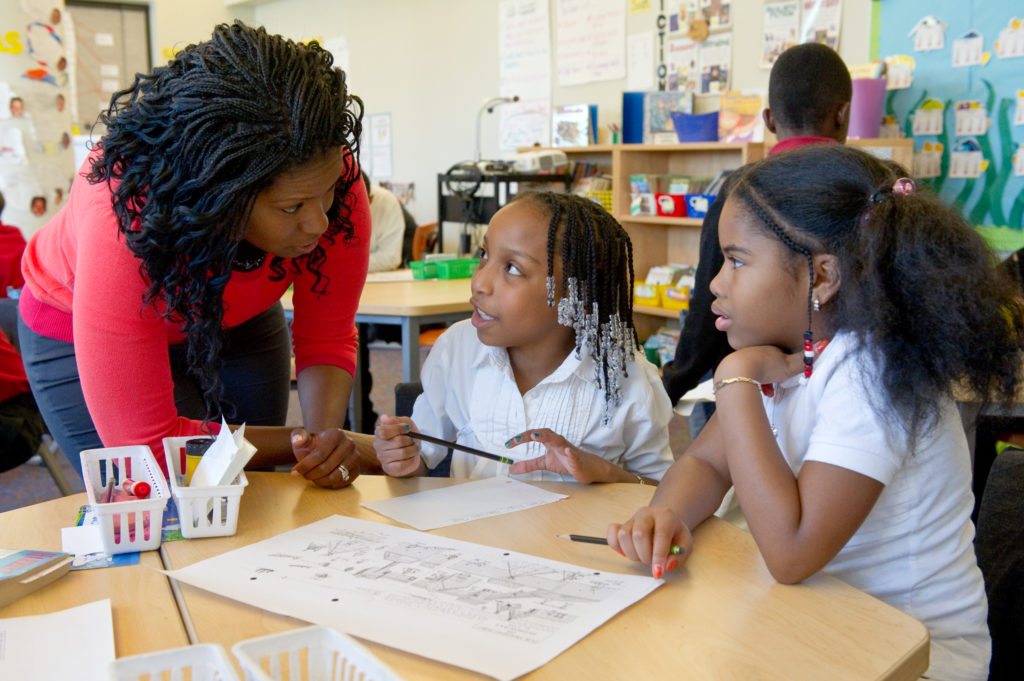
“Hello, Tasha! How’s your new baby brother?” the principal says as she greets a student in the hallway during morning arrival. Just then a teacher comments to a student at his classroom door, “Good morning, Aliya. It’s so nice to see you. I noticed that you remembered to walk quietly and safely in the hall the way we practiced.” A moment later, the school counselor firmly and respectfully says, “Nolan, remember, friendly words,” when Nolan begins to speak harshly to another student.
In scenes like these, it’s easy to see—and hear—that the adults at this school care about and know the students, believe in them, and see discipline as being about enabling children to choose positive behaviors. An overall tone of safety and caring is largely set by the adults’ positive language—what they say and how they say it.
Positive adult language is the professional use of words and tone of voice to enable students to learn in an engaged, active way. This includes learning social skills. To guide children toward choosing and maintaining positive behaviors, school adults need to carefully choose the words and tone of voice we use when speaking to them.
Learning to use positive language with children takes time. But you don’t have to do it all at once. Any enhancements you make in your language will do much to help children choose positive behaviors. The following three essentials offer a good starting place.
To choose positive behaviors, children need to see themselves as capable individuals and responsible community members. Adults can use positive language to help children build that self-perception.
Suppose a lunch teacher says to a class entering the lunchroom, “You can look at our poster to remind yourselves what to do when you finish eating.” These words convey belief that children want to cooperate, listen, and do good work, while also giving them information about how they can follow through on those good intentions.
With our words, we convey our assumptions and expectations about children, which, in turn, influence children’s assumptions and expectations about themselves. Imagine Shayna bouncing through the school doors in the morning. She sometimes forgets the school rule about walking down the hallway. But today she remembers. An adult in the hallway speaks to her. Compare these two statements:
(a) Shayna, don’t even think about running to your classroom this morning. I’m watching you!
(b) Good morning, Shayna! I’m so glad you’re here today. I see you’re remembering to walk safely in the hall.
These two ways of talking send very different messages:
(a) The first way communicates a lack of faith in Shayna’s ability to follow the rules. It also sets up the adult as an “enforcer,” undermining trust between the adult and the student.
(b) The second way communicates that the adult sees Shayna’s good intentions and responsible behavior and, most importantly, believes that she can succeed.
By using positive language to convey your belief in children’s abilities and intentions, you help them internalize a positive identity and develop more awareness and self-control. As a bonus, your language helps those within earshot form a positive perception of the child, which further enhances the child’s self-perception and helps to promote positive behavior.
Whether giving directions, noting positive behaviors, prompting children to remember rules, stopping misbehavior, or holding a discussion, it’s important to use clear, direct language that is free of innuendo or sarcasm. With words, tone of voice, facial expression, and body posture, you can communicate calmness and respect. In this way, you’ll avoid shaming and judging children, keep the focus on the positive behavior you want to see, and reduce the likelihood of power struggles.
Reinforcing language identifies and affirms students’ specific positive actions and encourages them to continue their appropriate behavior. For example, to a group that showed welcoming behavior toward one another at lunch, an adult might say, “I saw that you included everyone in your conversations. That helped make lunchtime pleasant for everyone at your table.” With these words, the adult lets the children know that he noticed their positive behaviors. He also helps them see how they and their classmates benefited from those behaviors.
The following guidelines will help you use this kind of language to highlight a variety of students’ strengths: their skills, their attitudes, or the process they used to do an assignment, form teams at recess, or sort out who will sit where at the lunch table.
Our words and tone of voice have a profound effect on children. By tuning in to the language we use with children, day in and day out, everywhere in school, we can empower our students, helping them to learn new skills and become their best selves.